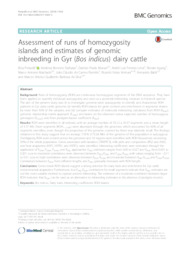Assessment of runs of homozygosity islands and estimates of genomic inbreeding in Gyr (Bos indicus) dairy cattle.
Assessment of runs of homozygosity islands and estimates of genomic inbreeding in Gyr (Bos indicus) dairy cattle.
Author(s): PERIPOLLI, E.; STAFUZZA, N. B.; MUNARI, D. P.; LIMA, A. L. F.; IRGANG, R.; MACHADO, M. A.; PANETTO, J. C. do C.; VENTURA, R. V.; BALDI, F.; SILVA, M. V. G. B.
Summary: Abstract BACKGROUND: Runs of homozygosity (ROH) are continuous homozygous segments of the DNA sequence. They have been applied to quantify individual autozygosity and used as a potential inbreeding measure in livestock species. The aim of the present study was (i) to investigate genome-wide autozygosity to identify and characterize ROH patterns in Gyr dairy cattle genome; (ii) identify ROH islands for gene content and enrichment in segments shared by more than 50% of the samples, and (iii) compare estimates of molecular inbreeding calculated from ROH (FROH), genomic relationship matrix approach (FGRM) and based on the observed versus expected number of homozygous genotypes (FHOM), and from pedigree-based coefficient (FPED). RESULTS: ROH were identified in all animals, with an average number of 55.12 ± 10.37 segments and a mean length of 3.17 Mb. Short segments (ROH1-2 Mb) were abundant through the genomes, which accounted for 60% of all segments identified, even though the proportion of the genome covered by them was relatively small. The findings obtained in this study suggest that on average 7.01% (175.28 Mb) of the genome of this population is autozygous. Overlapping ROH were evident across the genomes and 14 regions were identified with ROH frequencies exceeding 50% of the whole population. Genes associated with lactation (TRAPPC9), milk yield and composition (IRS2 and ANG), and heat adaptation (HSF1, HSPB1, and HSPE1), were identified. Inbreeding coefficients were estimated through the application of FROH, FGRM, FHOM, and FPED approaches. FPED estimates ranged from 0.00 to 0.327 and FROH from 0.001 to 0.201. Low to moderate correlations were observed between FPED-FROH and FGRM-FROH, with values ranging from -0.11 to 0.51. Low to high correlations were observed between FROH-FHOM and moderate between FPED-FHOM and FGRM-FHOM. Correlations between FROH from different lengths and FPED gradually increased with ROH length. CONCLUSIONS: Genes inside ROH islands suggest a strong selection for dairy traits and enrichment for Gyr cattle environmental adaptation. Furthermore, low FPED-FROH correlations for small segments indicate that FPED estimates are not the most suitable method to capture ancient inbreeding. The existence of a moderate correlation between larger ROH indicates that FROH can be used as an alternative to inbreeding estimates in the absence of pedigree records.
Publication year: 2018
Types of publication: Journal article
Unit: Embrapa Dairy Cattle
Keywords: Bos Indicus, Dairy traits, Inbreeding coefficients, ROH islands
Observation
Some of Embrapa's publications are published as ePub files. To read them, use or download one of the following free software options to your computer or mobile device. Android: Google Play Books; IOS: iBooks; Windows and Linux: Calibre.
Access other publications
Access the Agricultural Research Database (BDPA) to consult Embrapa's full library collection and records.
Visit Embrapa Bookstore to purchase books and other publications sold by Embrapa.

